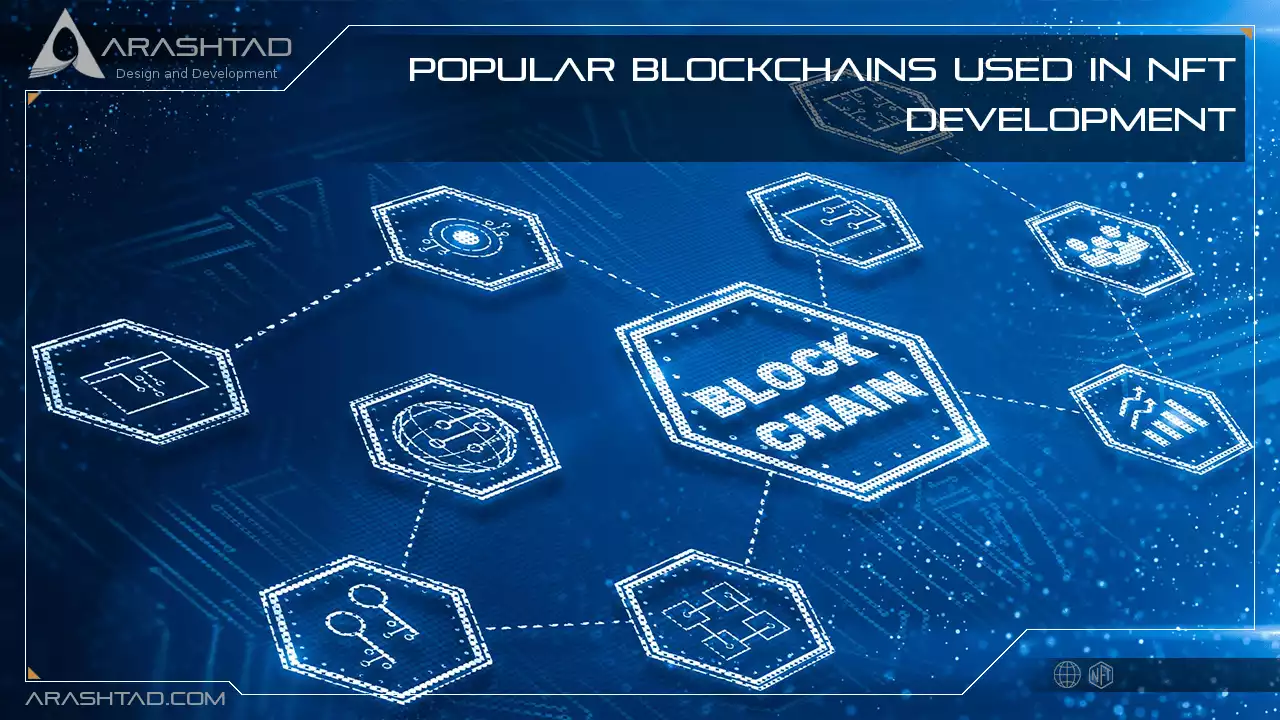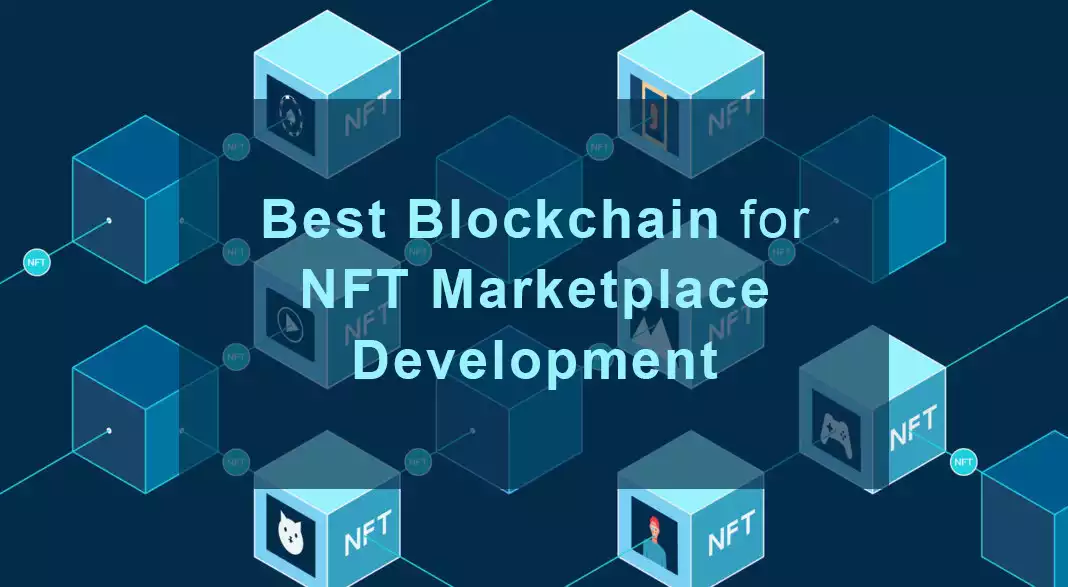Popular Blockchains Used in NFT Development
Several blockchains in the NFT area are gaining popularity, and NFT aficionados and crypto artists have been looking for alternatives to the Ethereum network due to its high transaction costs and environmental impact. It is essential to consider several factors to decide which blockchain to mint on. These include network scale, creator expenses, consumer purchasing patterns, security, and community involvement. To bring some clarity to the fast-paced world of web3 technology, we’ve put together a complete overview of blockchains for NFTs.
NFT blockchains vs. NFT marketplaces
In the absence of blockchains, NFTs lose their inherent property as immutable, verifiable, unique identifiers. Consequently, the NFT is useful for determining and validating ownership across various sectors, including art, intellectual property, real estate, and collectibles. In a public-accessible NFT marketplace, users can mint, buy, and sell NFTs. The majority of NFT blockchains offer their own marketplaces, but third-party marketplaces are also an option for users who wish to reach a broader audience. Here are some of the top blockchains powering the exciting world of NFTs.Popular Blockchains Used in NFT Development
Solana
As one of the most promising blockchain ecosystems for hosting and trading NFTs, the Solana blockchain offers a high throughput and low fees. A number of tools, smart contracts, and services related to NFT development are offered by the Solana blockchain under its own Metaplex brand umbrella. It introduces stateless smart contracts in contrast to the Ethereum blockchain and incorporates provisions for faster and cheaper transactions. There are two consensus mechanisms on the Solana blockchain: proof-of-stake (PoS) and proof-of-history.As an advantage of the Solana blockchain, the platform promises censorship-resistant and nonexistent transaction fees, attracting NFT traders and artists. In Solana, all NFT smart contracts are stateless, so nodes can confirm their validity without storing local validations. Additionally, smart contracts deployed on the Solana blockchain can be accessed by third parties and stored. As a result of eliminating the need for internal storage, Solana allows for lower NFT transaction costs.
Ethereum
Currently, Ethereum is the most popular blockchain for NFTs. It’s highly decentralized and offers all the financial and legal services one normally needs to conduct transactions without the need for intermediaries. As well as housing some of the most popular NFT marketplaces (OpenSea), cryptocurrency projects (CryptoPunks), and artists (Pak and Beeple), it also houses some of the most popular NFT projects).Because Ethereum uses a Proof-of-Work (PoW) mechanism, it is also among the most expensive options and consumes a great deal of energy. To add blocks to a blockchain, computers must compete with each other to solve complex puzzles. The puzzles are remarkably complex and require a lot of computer power to solve, resulting in enormous energy losses. Despite this, you should consider this blockchain first when deciding where to mint due to its popularity, security, decentralization, and ease of use.
Binance Smart Chain (BSC)
BSC is another good option if you want a sweet spot between fees and performance. However, high-speed transactions and low fees come with a price. BSC is the most centralized option on this list. To support short block times and low fees, Binance Smart Chain uses a consensus model called Proof of Staked Authority (PoSA). The 21 validators needed to run the exchange switch out every 24 hours, so the validators who run transactions take turns producing blocks. Some reports indicate 11 of the 21 Binance Chain validators are directly connected to the Binance Crypto Exchange.Despite centralization being a turn-off to many in the crypto and NFT ecosystem, the BSC NFT market began to pick up speed by the end of 2021. OpenBiSea, AirNFTs, JuggerWorld, and others are gaining popularity despite the lack of robust ecosystems like Ethereum.
Tron
Tron (TRX) supports the TRC-721 and TRC-165 standards for issuing NFTs, which are implemented by the TRC-721 network. TRX implements NFT standards to improve network performance through traffic management. Tron-based NFTs are also compatible with Ethereum’s ERC-721 standard. However, a wallet interface must be implemented to accept safe transfers when creating an NFT over Tron. One needs to create an account on Tronlink with at least 350 TRX as a minimum balance to issue TRC-721 tokens. Once NFT has been created, users can compile and deploy smart contracts using Tronscan.Polygon
Polygon is a secondary layer (L2) of Ethereum, previously known as Matic. Therefore, it enables users and developers to bridge portals and transfer assets between the primary mainnet and Polygon. Similarly to other blockchain alternatives to Ethereum, Polygon serves as a scaling solution for transactions that aim to reduce transaction costs and time. The Polygon L2 solution has a transaction finality speed of 26.08 transactions per minute (2.3 seconds per transaction) compared to Ethereum’s six transactions per minute (10 seconds per transaction).Users prefer Polygon over other popular blockchains because it requires no upfront costs to mint new NFTs. However, the network charges a predetermined amount (usually 2.5%) as a service fee to sell the newly minted NFTs.
Flow
Flow can handle billions of transactions per second, unlike Ethereum, and is built with performance in mind to build NFTs, games, and other decentralized applications (dApps). It has gained rapid popularity since its inception in 2019 as the NBA’s official blockchain partner. The Flow Blockchain, one of Dapper Labs’ (the company behind CryptoKitty) partners, was instrumental in helping NBA Top Shot become widely accepted and helped create NBA Top Shot.A Proof of Stake consensus is used to validate transactions on Flow, just like Tezos. Therefore, engineers are developing blockchain technology capable of handling 10,000 transactions per second. The Flow Blockchain is a popular location for athletic NFTs due to its low transaction costs. Users can trade Flow NFTs on major NFT platforms besides the NBA, NFL, UFC, and other sports leagues. On the Flow blockchain, fewer NFT markets and fewer individuals are trading NFTs than on Ethereum, like Solana.
Conclusion
There is no doubt that non-fungible tokens have emerged as the next big thing, gaining traction with both small and large companies eager to launch their campaigns. You should carefully select the blockchain on which your NFT campaign will run if you want it to be a long-term success. Before making a decision, think about what features are most important to you and compare the choices available on the market. For NFT project success, a blockchain system that supports fast transactions, cheap gas costs, a vibrant secondary market, IP governance, and cross-platform compatibility are essential.Download this Article in PDF format

Arashtad Custom Services
In Arashtad, we have gathered a professional team of developers who are working in fields such as 3D websites, 3D games, metaverses, and other types of WebGL and 3D applications as well as blockchain development.


